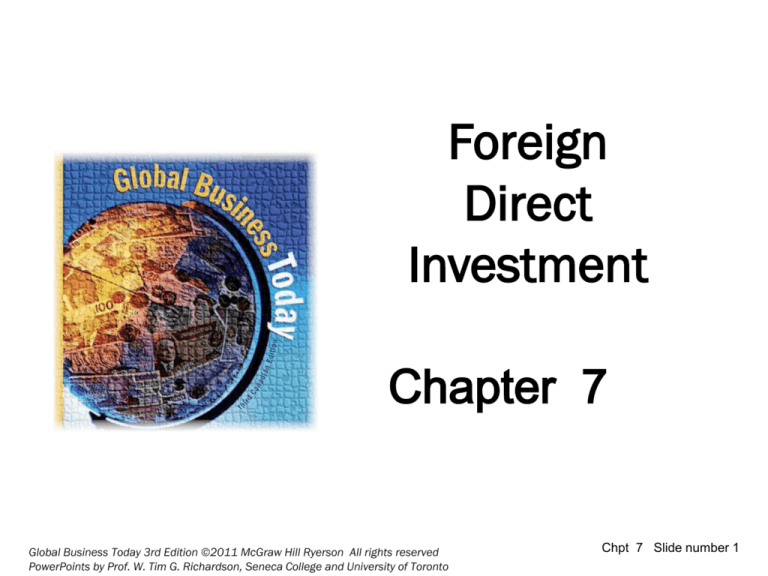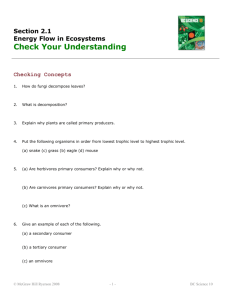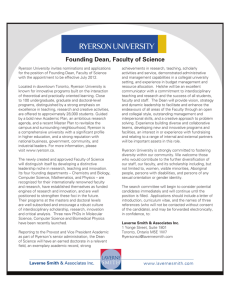
Foreign
Direct
Investment
Chapter 7
Global Business Today 3rd Edition ©2011 McGraw Hill Ryerson All rights reserved
PowerPoints by Prof. W. Tim G. Richardson, Seneca College and University of Toronto
Chpt 7 Slide number 1
Opening Case - Starbucks
In the late 1990s,
Starbucks
opened stores
in Taiwan,
China,
Singapore,
Thailand, New
Zealand, South
Korea, and
Malaysia.
Photo of Starbucks in Taipei, Taiwan by W.T.G. Richardson
In Asia, Starbucks’ most common strategy was to license its format to a
local operator in return for initial licensing fees and royalties on store
revenues
Global Business Today 3rd Edition ©2011 McGraw Hill Ryerson All rights reserved
PowerPoints by Prof. W. Tim G. Richardson, Seneca College and University of Toronto
Chpt 7 Slide number 2
Definitions
• Foreign Direct Investment (FDI)
•
•
The acquisition or construction of physical
capital ($$) by a firm from one (source)
country in another (host) country
Multinational Enterprise (MNE)
A firm that owns business operations in more
than one country
Green Field Investment
Establishing a new operation
in a foreign country
Global Business Today 3rd Edition ©2011 McGraw Hill Ryerson All rights reserved
PowerPoints by Prof. W. Tim G. Richardson, Seneca College and University of Toronto
Chpt 7 Slide number 3
Foreign Direct Investment in the World
Economy
• Flow of FDI refers to the amount of FDI
•
undertaken over a given time period
(normally a year).
Stock of FDI refers to the total
accumulated value of foreign-owned
assets at a given time.
Global Business Today 3rd Edition ©2011 McGraw Hill Ryerson All rights reserved
PowerPoints by Prof. W. Tim G. Richardson, Seneca College and University of Toronto
Chpt 7 Slide number 4
Foreign Direct Investment in the World
Economy
• Outflows of FDI refers to the flow
of FDI OUT of a country.
• This would mean Canadian companies
buying property and/or setting up operations
in another country
• Example – TD Bank in Canada buying
Commerce Bancorp in the U.S.
in 2007 and acquiring
all of their branches
Global Business Today 3rd Edition ©2011 McGraw Hill Ryerson All rights reserved
PowerPoints by Prof. W. Tim G. Richardson, Seneca College and University of Toronto
Chpt 7 Slide number 5
Foreign Direct Investment in the World
Economy
• Inflows of FDI refers to the
•
•
•
•
flow of FDI INTO a country.
When the CPR was being built across
Canada, the government gave land to the
CPR company and on this land the CPR
built many elaborate hotels and resorts some of which became famous Canadian
landmarks – like the Royal York Hotel in
Toronto.
In 2006, Fairmont (CP Hotels) sold out for
$3.8 billion to Saudi Prince Alwaleed bin
Talal bin Abdulaziz Alsaud
ThereforeCP Hotels were now foreign
owned
In 2010 the Prince sold some shares and
dropped to 35 per cent from 58 per cent
ownership
Global Business Today 3rd Edition ©2011 McGraw Hill Ryerson All rights reserved
PowerPoints by Prof. W. Tim G. Richardson, Seneca College and University of Toronto
Chpt 7 Slide number 6
UNCTAD
www.unctad.org
United Nations Conference on Trade and Development (UNCTAD)
Many people talking about FDI quote information from
UNCTAD
UNCTAD, a United Nations entity, is the most
authoritative and reliable source of information about
global FDI by country and by activity and its statistics
and diagrams are quoted equally by the right and left
wings.
Global Business Today 3rd Edition ©2011 McGraw Hill Ryerson All rights reserved
PowerPoints by Prof. W. Tim G. Richardson, Seneca College and University of Toronto
Chpt 7 Slide number 7
Growth of FDI
FDI Prospects in Developed Countries, 2007–2009:
Responses to UNCTAD survey (per cent of respondents)
Source: 2007 World Investment Review
Global Business Today 3rd Edition ©2011 McGraw Hill Ryerson All rights reserved
PowerPoints by Prof. W. Tim G. Richardson, Seneca College and University of Toronto
Chpt 7 Slide number 8
The World’s Top
100 Non-Financial
National
corporations
Ranked by Foreign
Assets, 2005 ($
millions)
Source: UNCTAD/Erasmus
University database, World
Investment Report, 2003.
Global Business Today 3rd Edition ©2011 McGraw Hill Ryerson All rights reserved
PowerPoints by Prof. W. Tim G. Richardson, Seneca College and University of Toronto
Chpt 7 Slide number 9
The Direction of FDI
•
•
Historically, most FDI has been directed at the
developed nations around the world, as firms based
in these countries invested in each others’ markets.
During the past few decades, the United States has
been the favourite target of FDI inflows.
• The U.S. is the only country in the world with a
population over 200 million AND a
comparatively high GDP per capita
• Which simply means there are a lot of
Americans, and they have a lot of money to
buy stuff
Global Business Today 3rd Edition ©2011 McGraw Hill Ryerson All rights reserved
PowerPoints by Prof. W. Tim G. Richardson, Seneca College and University of Toronto
Chpt 7 Slide number 10
Source of FDI
•
•
Since World War II, the United States has been the
largest source country for FDI,
a position it retained during the late 1990s and
throughout the 2000s.
•
•
Meaning American companies are going to other countries
and buying up other companies and resources
Other important source countries include
•
•
•
The United Kingdom,
France,
and Japan.
Global Business Today 3rd Edition ©2011 McGraw Hill Ryerson All rights reserved
PowerPoints by Prof. W. Tim G. Richardson, Seneca College and University of Toronto
Chpt 7 Slide number 11
Forms of FDI:
Acquisitions vs. Green Field Investment
FDI can take the form of:
Acquisition of, or a merger with, an
existing local firm in the destination
market
Green Field Investment in a new facility
in the destination market
• The majority of cross-border investment is in the form
of mergers and acquisitions rather than Green Field
Investments
Global Business Today 3rd Edition ©2011 McGraw Hill Ryerson All rights reserved
PowerPoints by Prof. W. Tim G. Richardson, Seneca College and University of Toronto
Chpt 7 Slide number 12
Definitions
• Green Field Investment
This is a slang expression which originally
referred to the fact that many of these
types of investments involved the buying
of real-estate and building something
That is to say: there was a
“green field” and the land was
bought for the purpose of
erecting some structure
Global Business Today 3rd Edition ©2011 McGraw Hill Ryerson All rights reserved
PowerPoints by Prof. W. Tim G. Richardson, Seneca College and University of Toronto
Chpt 7 Slide number 13
Canada’s Case
FDI Flows into Canada and Canadian Direct Investment,
1993–2006 ($ billions)
- Companies of other countries investing in Canada
Source: Statistics Canada, CANSIM
Global Business Today 3rd Edition ©2011 McGraw Hill Ryerson All rights reserved
PowerPoints by Prof. W. Tim G. Richardson, Seneca College and University of Toronto
Chpt 7 Slide number 14
Canada’s Case
FDI Flows into Canada and Canadian Direct Investment,
2000 - 2009 ($ billions)
- Companies of other countries investing in Canada
Global Business Today 3rd Edition ©2011 McGraw Hill Ryerson All rights reserved
PowerPoints by Prof. W. Tim G. Richardson, Seneca College and University of Toronto
Chpt 7 Slide number 15
Canada’s Case
Canadian Foreign Direct Investment Abroad, by Top-10 Destinations,
2006 ($ billions)
Source: Industry Canada
Global Business Today 3rd Edition ©2011 McGraw Hill Ryerson All rights reserved
PowerPoints by Prof. W. Tim G. Richardson, Seneca College and University of Toronto
Chpt 7 Slide number 16
Canada’s Case
Canadian Foreign Direct Investment Abroad, by Top-10 Destinations,
2009 ($ billions)
Global Business Today 3rd Edition ©2011 McGraw Hill Ryerson All rights reserved
PowerPoints by Prof. W. Tim G. Richardson, Seneca College and University of Toronto
Chpt 7 Slide number 17
Canada - U.S.
• In the field of international trade, until 2007,
•
Canada and the United States shared the
largest bilateral flow of goods, services,
people, capital, and investments between any
two countries in the world.
In 2008 China nudged passed Canada as top
exporter to the United States
•
It should be noted a large part of Chinese exports to the U.S.
are in fact from American companies in China, like Nike
exporting to Nike USA, and subsidiary companies of WalMart exporting to Wal-Mart USA
Global Business Today 3rd Edition ©2011 McGraw Hill Ryerson All rights reserved
PowerPoints by Prof. W. Tim G. Richardson, Seneca College and University of Toronto
Chpt 7 Slide number 18
Canada - U.S.
•
•
•
•
During this same time frame, Canada’s exports to the
United States totalled $313 billion USD,
Mexican exports to the U.S. where $210 billion USD
The recent and dramatic strengthening in the
Canadian dollar has given firms looking to expand
south of the border substantially increased buying
power
For the most part, gains in FDI outflow are owing to
the rise of Canadian affiliates and subsidiaries in the
United States.
Global Business Today 3rd Edition ©2011 McGraw Hill Ryerson All rights reserved
PowerPoints by Prof. W. Tim G. Richardson, Seneca College and University of Toronto
Chpt 7 Slide number 19
Why Foreign Direct Investment
…when two alternatives are
available?
• Exporting and
• Licensing
• The question is an important one given that
foreign direct investment can be both
expensive and risky when compared to
exporting and licensing.
Global Business Today 3rd Edition ©2011 McGraw Hill Ryerson All rights reserved
PowerPoints by Prof. W. Tim G. Richardson, Seneca College and University of Toronto
Chpt 7 Slide number 20
licensing
• Occurs when a firm (the licensor)
•
licenses the right to produce its product,
use its production processes, or use its
brand name or trademark to another
firm (the licensee).
In return for giving the licensee these
rights, the licensor collects a royalty fee
on every unit the licensee sells.
Global Business Today 3rd Edition ©2011 McGraw Hill Ryerson All rights reserved
PowerPoints by Prof. W. Tim G. Richardson, Seneca College and University of Toronto
Chpt 7 Slide number 21
Why Foreign Direct Investment?
• FDI is expensive because a firm
•
must bear the costs of establishing
production facilities in a foreign country
or of acquiring a foreign enterprise.
FDI is risky because of the problems
associated with doing business in a different
culture where the “rules of the game” may be
very different.
Global Business Today 3rd Edition ©2011 McGraw Hill Ryerson All rights reserved
PowerPoints by Prof. W. Tim G. Richardson, Seneca College and University of Toronto
Chpt 7 Slide number 22
Why Foreign Direct Investment?
Because limitations of exporting and licensing
are means for capitalizing on foreign market opportunities.
Limitations of Exporting
Limitations of Licensing
Exporting is constrained by transportation
costs and trade barriers. When
transportation costs are added to
production costs, it becomes unprofitable to
ship some products over a large distance.
Products of low value-to-weight ratio can
be produced in almost any location
Examples: cement, soft drinks
Products with a high value-to weight ratio:
transport costs are normally a very minor
component of total landed cost.
Examples: electronic components,
personal computers, medical equipment
Internalization theory explains why firms
often prefer foreign direct investment over
licensing as a strategy for entering foreign
markets.
1.Licensing may result in a firm giving
away valuable technological know-how to a
potential foreign competitor.
2.Licensing does not give a firm the tight
control over manufacturing, marketing, and
strategy in a foreign country.
3.When the firm’s competitive advantage is
based not so much on its products, as on
the management, marketing, and
manufacturing capabilities that produce
those products.
Global Business Today 3rd Edition ©2011 McGraw Hill Ryerson All rights reserved
PowerPoints by Prof. W. Tim G. Richardson, Seneca College and University of Toronto
Chpt 7 Slide number 23
Pattern of Foreign Direct Investment
• Strategic Behaviour
• Oligopoly
• An industry composed of a limited number of large
firms.
• Multipoint competition
• Happens when two or more enterprises encounter each
other in different regional markets, national markets, or
industries.
Global Business Today 3rd Edition ©2011 McGraw Hill Ryerson All rights reserved
PowerPoints by Prof. W. Tim G. Richardson, Seneca College and University of Toronto
Chpt 7 Slide number 24
Pattern of Foreign Direct Investment
• Eclectic Paradigm
• An economic model used to evaluate
a company's strategy to expand
its operations through foreign direct
investment.
Global Business Today 3rd Edition ©2011 McGraw Hill Ryerson All rights reserved
PowerPoints by Prof. W. Tim G. Richardson, Seneca College and University of Toronto
Chpt 7 Slide number 25
Eclectic Paradigm MODEL
Global Business Today 3rd Edition ©2011 McGraw Hill Ryerson All rights reserved
PowerPoints by Prof. W. Tim G. Richardson, Seneca College and University of Toronto
Chpt 7 Slide number 26
The “Political Environment” and FDI
How Political Ideology effects Foreign Direct Investment
• Government policy toward FDI has typically
•
been driven by political ideology.
Historically, ideology toward FDI has ranged
from a radical stance that is hostile to all, to the
non-interventionist principle of free market
economics
Starbucks – Seoul
By W.T.G. Richardson
Global Business Today 3rd Edition ©2011 McGraw Hill Ryerson All rights reserved
PowerPoints by Prof. W. Tim G. Richardson, Seneca College and University of Toronto
Chpt 7 Slide number 27
The “Political Environment” and FDI
How Political Ideology effects Foreign Direct Investment
The radical view
•
•
•
The radical view - Marxist political and economic theory
Argues that the multinational enterprise (MNE) is an
instrument of imperialist domination
They see the MNE as a tool for exploiting host countries
to the exclusive benefit of their capitalist-imperialist
home countries
Global Business Today 3rd Edition ©2011 McGraw Hill Ryerson All rights reserved
PowerPoints by Prof. W. Tim G. Richardson, Seneca College and University of Toronto
Chpt 7 Slide number 28
The “Political Environment” and FDI
How Political Ideology effects Foreign Direct Investment
• The radical view
•
They argue that MNEs extract profits from the host
country and take them to their home country
Starbucks - Beijing
Global Business Today 3rd Edition ©2011 McGraw Hill Ryerson All rights reserved
PowerPoints by Prof. W. Tim G. Richardson, Seneca College and University of Toronto
Chpt 7 Slide number 29
The “Political Environment” and FDI
How Political Ideology effects Foreign Direct Investment
The free market view
•
•
argues that international production should be
distributed among countries according to the theory of
comparative advantage.
That is, countries should specialize in the production of
those goods and services that they can produce most
efficiently
Global Business Today 3rd Edition ©2011 McGraw Hill Ryerson All rights reserved
PowerPoints by Prof. W. Tim G. Richardson, Seneca College and University of Toronto
Chpt 7 Slide number 30
The “Political Environment” and FDI
How Political Ideology effects Foreign Direct Investment
Pragmatic Nationalism
•
•
•
In practice, many countries have adopted neither a
radical policy nor a free market policy toward FDI, but
instead a policy that can best be described as
pragmatic nationalism.
The pragmatic nationalist view is that FDI has both
benefits and costs.
FDI can benefit a host country by bringing capital, skills,
technology, and jobs, but those benefits often come at a
cost.
Global Business Today 3rd Edition ©2011 McGraw Hill Ryerson All rights reserved
PowerPoints by Prof. W. Tim G. Richardson, Seneca College and University of Toronto
Chpt 7 Slide number 31
Benefits of FDI to the Nation State
Host Country
Home Country
• Resource-transfer effects
• Employment effects - FDI brings
• Balance of payments from
jobs to a host country
• Balance of payment effects.
• FDI is a substitute for imports of
goods and services
• MNE uses the subsidiary in the
host country to export goods
and services to other countries
inward flow of foreign earnings.
• Positive employment effects
when a subsidiary demands
home country exports of capital
equipment.
• Home country MNE learns skills
transferable in technologies for
use in the home country.
Global Business Today 3rd Edition ©2011 McGraw Hill Ryerson All rights reserved
PowerPoints by Prof. W. Tim G. Richardson, Seneca College and University of Toronto3
Chpt 7 Slide number 32
Costs of FDI to the Nation State
Host Country
Home Country
• Adverse effects on competition
• Balance of payments from
Foreign subsidiaries have strong
economic power to put local
competitors out of market
• Adverse effects on the balance
outward FDI
• Employment effect from outward
FDI
of payments.
Against the initial capital inflow that
comes with FDI must be the outflow
of earnings to be repatriated
• National sovereignty and
autonomy
Global Business Today 3rd Edition ©2011 McGraw Hill Ryerson All rights reserved
PowerPoints by Prof. W. Tim G. Richardson, Seneca College and University of Toronto
Chpt 7 Slide number 33
Key Term games
online game
Global Business Today 3rd Edition ©2011 McGraw Hill Ryerson All rights reserved
PowerPoints by Prof. W. Tim G. Richardson, Seneca College and University of Toronto
Chpt 7 Slide number 34


